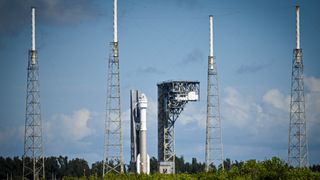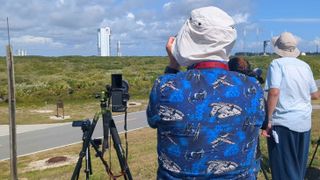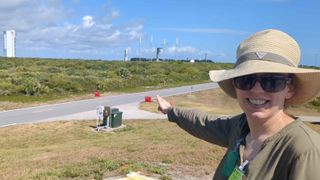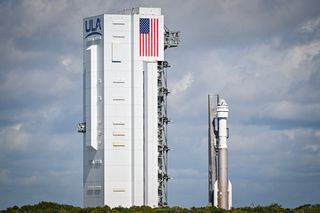
A United Launch Alliance Atlas V rocket, topped with the Boeing Starliner spacecraft, rolls out to its launch pad at Cape Canaveral Space Force Station on May 4, 2024.
(Image credit: Miguel J. Rodriguez Carrillo / AFP via Getty Images)
CAPE CANAVERAL — May the rocket’s Force be with you!
An Atlas V rocket rolled out to its launch pad on Saturday (May 4), also Star Wars Day, at Cape Canaveral Space Force Station days before its historic first mission with astronauts. Atop the United Launch Alliance booster was Boeing’s Starliner spacecraft, which will also make its debut flight with humans onboard after launching no earlier than Monday (May 6).
The instantaneous launch window opens at 10:34 p.m. EDT (0234 GMT on Tuesday, May 7) and you can watch the historic International Space Station (ISS) mission live here at Space.com, courtesy of NASA Television.
The mission, called Crew Flight Test (CFT), will send two veteran NASA astronauts and former U.S. Navy test pilots aloft: Butch Wilmore will command the mission and Suni Williams will be the pilot. The duo are quarantining at the nearby Kennedy Space Center.
Related: I flew Boeing’s Starliner spacecraft in 4 different simulators. Here’s what I learned (video, photos)
I joined a group of about 35 reporters on a small hill about a mile away from Space Launch Complex 41 for my first-ever Floridian rocket rollout in which the booster was always going the right way towards the pad.

A photographer festooned in Star Wars gear watches Boeing Starliner, atop the United Launch Alliance Atlas V rocket, make its way to the launch pad at Cape Canaveral Space Force Station on May 4, 2024. (Image credit: Elizabeth Howell)
Back in August 2006, I made an attempt to see mission STS-115 fly to the ISS. Then life happened. During my flight from Canada to the Space Coast, space shuttle Atlantis’s launch pad was hit by lightning. As NASA took time to double-check all systems, Tropical Storm Ernesto made its way up the coast.
Breaking space news, the latest updates on rocket launches, skywatching events and more!
So instead of a launch, I witnessed Atlantis being pulled back towards shelter — and then pause in its path to the Vehicle Assembly Building, and get pulled back to the launch pad when the tropical storm shifted far enough away to make that the safe choice. I definitely missed that launch, but no regrets, as that situation was a pretty unique one.

Space.com staff writer Elizabeth Howell points towards a United Launch Alliance Atlas V rocket, stacked with Boeing Starliner, as the rocket makes its way to the launch pad at Cape Canaveral Space Force Station on May 4, 2024. (Image credit: Elizabeth Howell)
Starliner’s presence here two decades later is also unique, as the first spacecraft to bring astronauts to space from the Cape Canaveral side since Apollo 7 on Oct. 11, 1968.
And no human has ridden any Atlas rocket since Gordon Cooper’s Mercury-Atlas 9 mission on May 15, 1963 (almost exactly 61 years before Starliner’s CFT launch attempt.)
If CFT goes to plan, Boeing will soon join SpaceX in sending astronauts for six months at a time to the ISS. That’s after both companies received commercial crew contracts from NASA in 2014, valuing Boeing’s at $4.2 billion back then, compared to SpaceX’s $2.6 billion.

Boeing’s Starliner spacecraft, atop a United Launch Alliance Atlas V rocket, makes its way towards the launch pad at Cape Canaveral Space Force Station on May 4, 2024. Beside it is a ULA stacking facility. (Image credit: Miguel J. Rodriguez Carrillo / AFP via Getty Images)
While SpaceX has sent 12 crewed missions to ISS since 2020, including an astronaut test flight, Starliner’s waited four extra years. Boeing’s first ISS flight in December 2019 was dogged with so many computer glitches that Starliner never made it to its assigned orbit. After the COVID-19 pandemic erupted, and dozens of fixes were implemented, and Starliner at last made a successful second uncrewed test flight in May 2022.
CFT was also expected to launch earlier, most recently 2023. Critical issues found last year delayed that, however, as Boeing officials sought to address issues with the loads on the capsule’s main parachutes, as well as wiring covered in flammable tape.
NASA and Boeing have carefully gone over all details ahead of this flight and maintained at a press conference Friday (May 3) that all is ready to go safety-wise. Weather is also 95% go for Monday’s launch attempt on the Space Coast; that said, checks for proper technical fit and good weather will continue up to the moment of liftoff.
Related: 1st Boeing Starliner astronauts are ready to launch to the ISS for NASA (exclusive)
The spacecraft’s first operational mission will be Starliner-1, no earlier than 2025, and it will send at least three astronauts to the ISS: NASA’s Mike Fincke (who is also serving as a CFT backup astronaut), alongside NASA’s Scott Tingle and the Canadian Space Agency’s Joshua Kutryk (the capcom for CFT’s ascent phase.)
NASA plans to alternate SpaceX’s Dragon and Boeing’s Starliner in sending up astronauts at least every six months from U.S. soil. Russia’s Soyuz spacecraft will also continue to send some agency astronauts aloft, for technical and policy reasons.
While NASA aims to have these commercial crew vehicles working past the lifetime of ISS, the orbiting complex is expected to finish operations in 2030. Russia may pull out as soon as 2028, although all timelines are subject to flux as the countries work on implementing next-generation space programs.
Join our Space Forums to keep talking space on the latest missions, night sky and more! And if you have a news tip, correction or comment, let us know at: [email protected].
Elizabeth Howell (she/her), Ph.D., is a staff writer in the spaceflight channel since 2022 covering diversity, education and gaming as well. She was contributing writer for Space.com for 10 years before joining full-time. Elizabeth’s reporting includes multiple exclusives with the White House and Office of the Vice-President of the United States, an exclusive conversation with aspiring space tourist (and NSYNC bassist) Lance Bass, speaking several times with the International Space Station, witnessing five human spaceflight launches on two continents, flying parabolic, working inside a spacesuit, and participating in a simulated Mars mission. Her latest book, “Why Am I Taller?”, is co-written with astronaut Dave Williams. Elizabeth holds a Ph.D. and M.Sc. in Space Studies from the University of North Dakota, a Bachelor of Journalism from Canada’s Carleton University and a Bachelor of History from Canada’s Athabasca University. Elizabeth is also a post-secondary instructor in communications and science at several institutions since 2015; her experience includes developing and teaching an astronomy course at Canada’s Algonquin College (with Indigenous content as well) to more than 1,000 students since 2020. Elizabeth first got interested in space after watching the movie Apollo 13 in 1996, and still wants to be an astronaut someday. Mastodon: https://qoto.org/@howellspace
>>> Read full article>>>
Copyright for syndicated content belongs to the linked Source : Space.com – https://www.space.com/boeing-starliner-crew-flight-test-launch-pad-rollout































